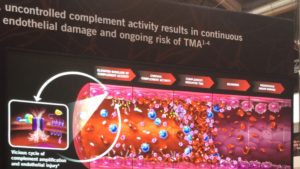Like many with rare diseases getting a diagnosis is a major issue for aHUS patients. Although it is much speedier than it used to be , getting a diagnosis is still a barrier for many to get access to treatment which can stop the damage that aHUS does.
Except strictly it is not aHUS that is doing the damage , after all “haemolytic”and “uremic”are just the description of the patient’s symptoms . It is thrombotic microangiopathy or TMA that is doing the damage.

TMA in action
It is doing damage because it is causing excessive clotting ( thrombotic ) causing problems in the small blood vessels( microangiopathy); those excessive clots are causing the red blood cells to be destroyed as they are pushed through ever more narrowing passage ways until they literally explode.The cell fragments go on to clog up the small blood vessels in major organs like the kidney.
So aHUS patients experience a combination of anaemia and acute kidney failure. Untreated, death or chronic kidney failure can result.
But aHUS is not the only disease resulting from TMA.
TMA is in itself a rare and serious condition that happens to different people for different reasons. It begins either because of an injurious event ,caused by viruses and bacteria, to the lining of the blood vessels (endolethium); or because of a precipitating condition,
Symptoms that aHUS ‘ TMA has in common with other TMAs include : fatigue, dizziness, shortness of breath , bruises, gum/nose bleeds, excessive bleeding from small cuts, confusion, sleepiness, seizures, decreased urine, swollen legs, high blood pressure and fever.
These are just the symptoms in common add in the ones that are not common to all and a very confusing picture emerges. ( see synopsis of an “House” episode below)
The likelihood a simple and common cause for the condition will be sought first – e.g. dehydration. How many aHUS patients have been told to go home and drink more fluids?!
When that does not work the elimination process has begun. Thinking Kidney but that is a long way from Thinking aHUS.
Before that Thinking TTP ( Thrombotic Thrombocytopenic Purpura) is necessary, although very rare it is thought to be more common than aHUS ; but for a long time TTP/HUS were synonymous. (HUS diagnosis can be eliminated by tests for e.coli.)
Thinking about TTP however will not happen until TMA is thought about and that is rare too. Like TTP/HUS , until 65 years ago this year TTP/TMA were regarded the same until in October 1952 Prof W Symmers published an article and propose thrombotic microangiopathy as the name for a separate condition ( he had used Thrombotic Microangiopathic Haemolytic Anaemia but chose to shorten it ) ( see full article in website Info Centre by clicking here )
So Thinking TMA is a very important diagnosis hurdle to get over for aHUS patients and eventually clinicians will get there in the end.
*A synopsis of an episode of HOUSE
The medical drama House did not feature a story about aHUS .
One episode did feature TTP. The episode focused on a twelve year old girl who attended House’s hospital to be checked out for meningitis along with hundreds of others as a town was in the midst of a meningitis epidemic !
The girl had symptoms of meningitis, a fever with a rash and her neck hurt when it shook from side to side BUT it also hurt when she nodded. House suspected she did not have meningitis as it does not cause nodding neck pain! He does not know what is causing her symptoms; but checks for meningitis anyway by undertaking a lumbar puncture. It is not meningitis.
Then the girl has unexplained bleeding from the mouth. House thinks it could be bone cancer.
So House organises a bone marrow biopsy to be done. As the girl is being told that it is not likely to be cancer, she has a seizure!
She begins to have more seizures House suspects she might have been poisoned so he calls for a CT scan brain but the service is overwhelmed by the meningitis epidemic, so an ultrasound is done instead . They also carry out tox-screening but it proves to be negative . The ultrasound reveals some inter cranial bleeding and a neurosurgeon is called and an operation is performed to relieve the pressure on the brain.
House has no answers. ( He begins to THINK TMA)
Her blood tests show her red blood cells are intact, but House orders another check of her blood. He finds that the girl has not really got a rash – she is bleeding into her skin he thinks it is TTP or Thrombotic thrombocytopenic purpura. ( He is TTP Aware)
However House thinks only two obvious things can set off an episode of TTP – an E. coli infection ( Is he HUS Aware ) which she does not have according to tests: or the menopause. However, House considers another cause of the disorder is unlikely, but possible. Pregnancy may be causing her blood to clot and then be shredded by the clot – a rare complication ( TMA!) A foetus is found on an ultrasound and House decides to terminate the pregnancy and treat the girls blood for antibodies. (No mention of plasma exchange!)
This episode appears in the 2005 season ( 1/19) and the usual tests today for TTP ( including ADAMTS-13 deficiency tests) were known then; but that would not have created a drama out of a crisis.
Pregnancy is a known trigger for aHUS too, what was it about the scenario that would have ruled in a possible aHUS diagnosis? A normal ADAMTS-13 level , perhaps less neurological symptoms but certainly more kidney problems.
A more in depth account about TMA’s on the alliance website can be read here
Note : The featured image is a cropped photo of the Alexion display at the ERA-EDTA Conference 2017 in Madrid.

